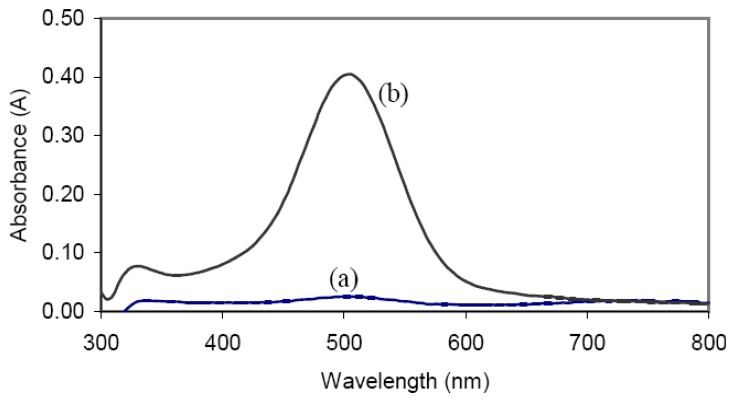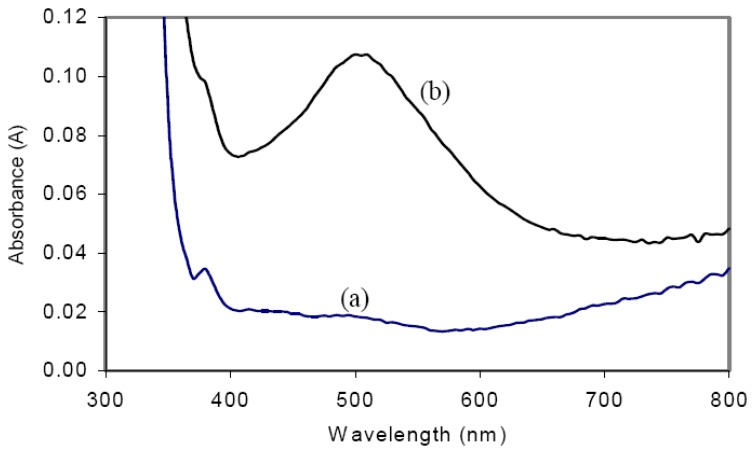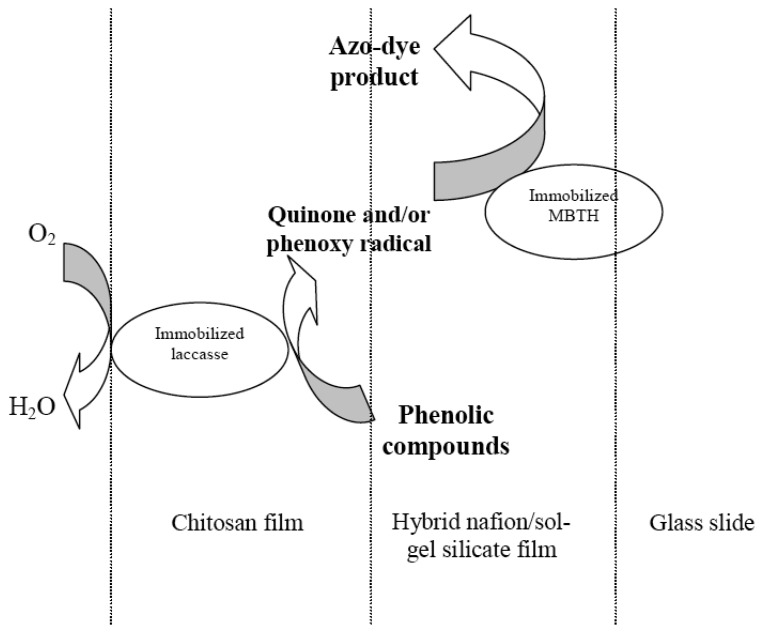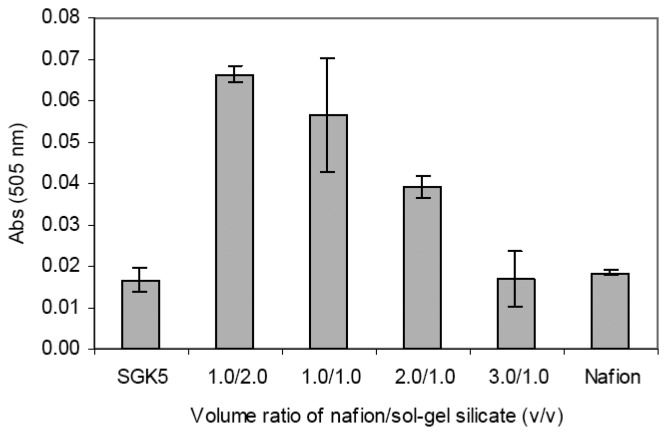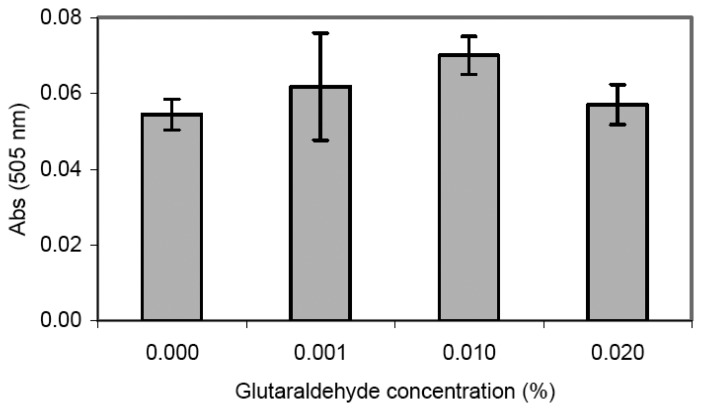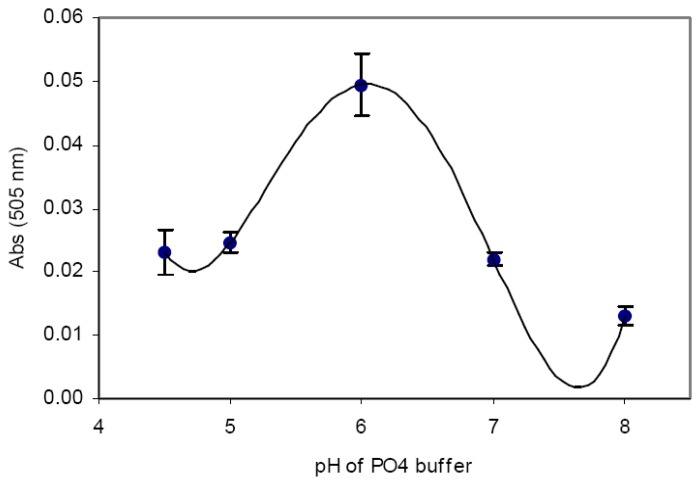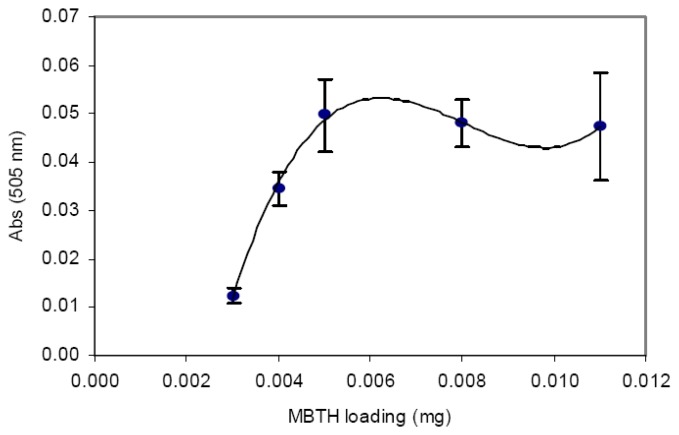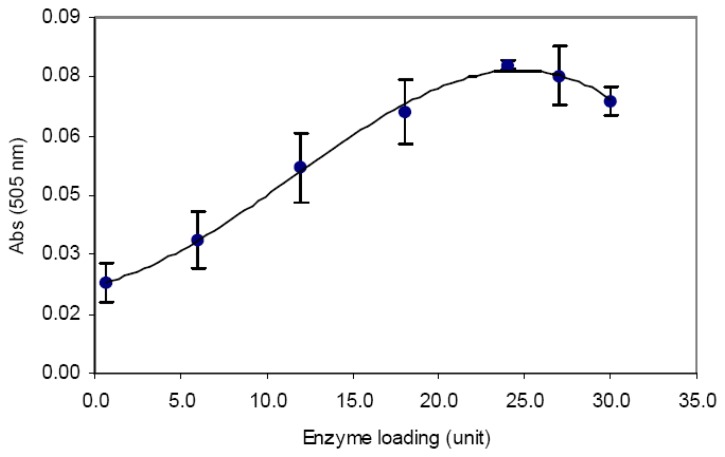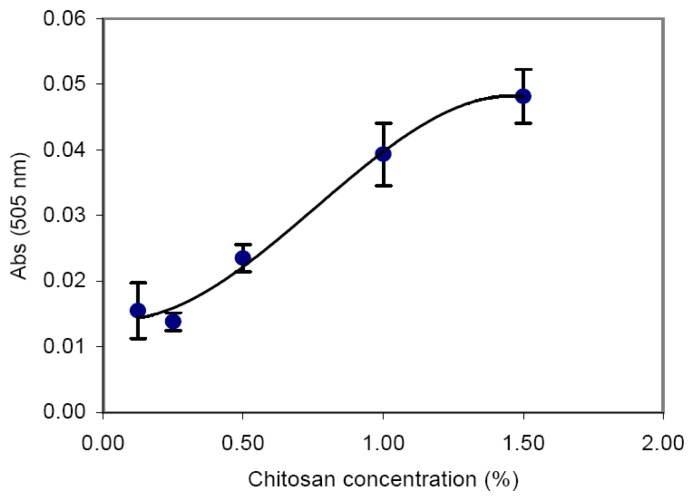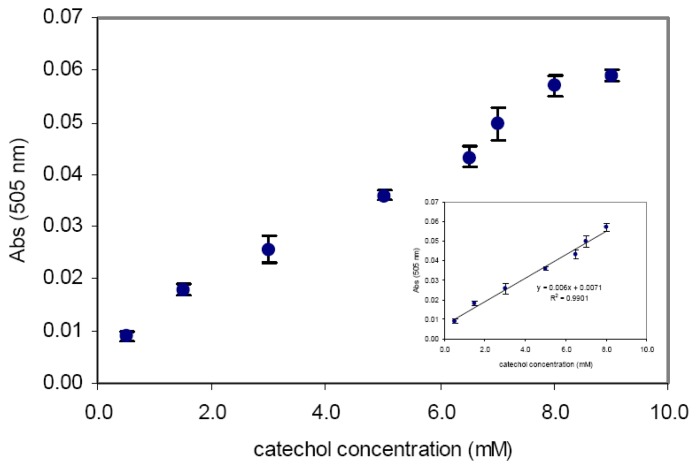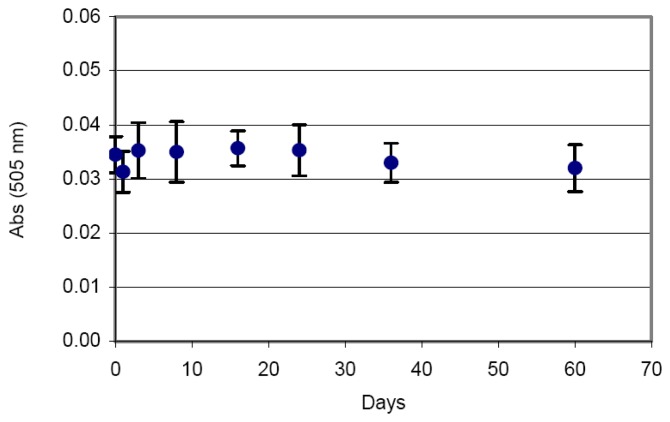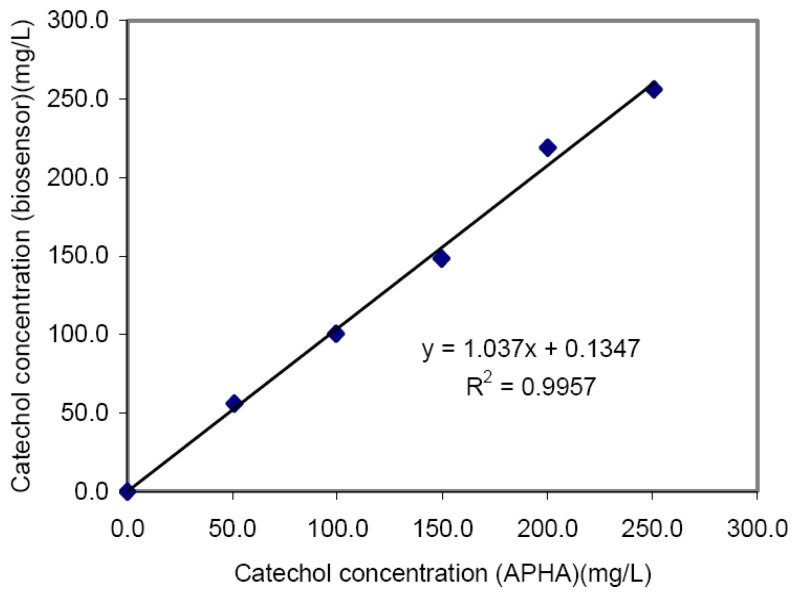Abstract
The fabrication of an optical biosensor by using stacked films where 3-methyl-2-benzothiazolinone hydrazone (MBTH) was immobilized in a hybrid nafion/sol-gel silicate film and laccase in a chitosan film for the detection of phenolic compounds was described. Quinone and/or phenoxy radical product from the enzymatic oxidation of phenolic compounds was allowed to couple with MBTH to form a colored azo-dye product for spectrophometric detection. The biosensor demonstrated a linear response to catechol concentration range of 0.5-8.0 mM with detection limit of 0.33 mM and response time of 10 min. The reproducibility of the fabricated biosensor was good with RSD value of 5.3 % (n = 8) and stable for at least 2 months. The use of the hybrid materials of nafion/sol-gel silicate to immobilize laccase has altered the selectivity of the enzyme to various phenolic compounds such as catechol, guaicol, o-cresol and m-cresol when compared to the non-immobilized enzyme. When immobilized in this hybrid film, the biosensor response only to catechol and not other phenolic compounds investigated. Immobilization in this hybrid material has enable the biosensor to be more selective to catechol compared with the non-immobilized enzyme. This shows that by a careful selection of different immobilization matrices, the selectivity of an enzyme can be modified to yield a biosensor with good selectivity towards certain targeted analytes.
Keywords: Biosensor, laccase, MBTH, phenolic compounds
1. Introduction
Phenolic compounds are widely used for many industries such as the production of paper pulp, plastics and resins, dyes and agriculture [1,2]. These processes generate large volume of phenolic compounds effluents which, exhibit different toxicity. Phenolic compounds identified in this kind of effluent include phenols, catechols, guaiacols and cresols. Therefore, their determination is very important due to its toxicity and persistency in the environment [1,2]. In Malaysia, the maximum acceptable limit of phenolic compounds in sewage and industrial effluents is in the range of 1-5 ppm (mg/L) [3]. Spectrophotometric, gas chromatography, liquid chromatography and capillary electrophoresis are the commonly used methods for the determination of phenolic compounds. However, these methods are time consuming including complicate sample pre-treatment [4]. In addition, the equipment is expensive and is not generally portable. Therefore, there is an interest in developing simple, sensitive, specific, accurate and portable system such as biosensor for determination of phenolic compounds.
Many biosensor research papers have been reported previously for the detection of phenolic compounds based on several types of enzyme such as tyrosinase [5,6], laccase [7,8] and horseradish peroxidase (HRP) [9]. However, reaction mechanisms of the biosensors based on tyrosinase, laccase and HRP are different for various types of phenolic compounds. For tyrosinase and laccase, the enzyme molecules are reduced by phenolic compounds after being oxidized by oxygen [10]. For HRP, it is oxidized by hydrogen peroxide after its reduction by phenolic compounds [11]. Tyrosinase based biosensor can be used for the monitoring of phenolic compounds with ortho-position of the phenol ring free of substituent group [12]. But for phenolic compounds with para- and meta-position free of substituent group, laccase based biosensor can be used. However its catalytic behaviour is complex [13].
Laccases are multi-copper-containing enzymes, is widely distributed in fungi, higher plants and some in bacteria [14]. It is able catalyze oxidative conversion of a variety of chemicals such as phenols, mono-, di-, and polyphenols and aromatic amines, with concomitant reduction of dioxygen to water and its specific affinity for oxygen, as the electron acceptor is very high [8]. Setti et al. [15] have investigated reaction of methoxyphenols with laccase in the presence of 3-methyl-2-benzothiazolinone hydrazone (MBTH). The findings described the ability and efficacy of laccase to catalyze the oxidative coupling reactions leading to the formation of azo-dye products, which can be monitored spectrophotometrically.
Therefore, based on this concept, we have developed an optical biosensor using stacked films immobilization of MBTH in hybrid nafion/sol-gel silicate and laccase in chitosan for the detection of phenolic compounds. To our knowledge, there is no report on optical biosensor using the combination of MBTH-laccase as sensing materials. The biosensor described here employed a color reagent, MBTH, which interacts with the quinones and/or free radical of phenols produced by the enzyme to form azo-dye products. The hybrid nafion/sol-gel silicate used in this work yielded enough hydrophobic and porosity properties to allow the MBTH reagent to be retained and its leaching was prevent [6,9]. Nafion is a polymer that has hydrophobic fluorocarbon backbone but hydrophilic cation-exchange site thus exhibits moderate hydrophobicity, and it was also observed to overcome the problem of film brittleness and shrinkage, which normally occurred when a pure sol-gel silicate film alone was used [16].
2. Experimental
2.1. Reagents
Laccase (EC 1.10.3.2 and isoelectric point of pH 3.2), catechol, guaiacol, o-cresol, m-cresol and p-cresol were purchased from Sigma. Nafion (5 % solution in a mixture of alcohol) was supplied by Aldrich. Hydrochloric acid (37%) and acetic acid glacial were obtained from R & M Chemicals and Ajax Chemicals whereas MBTH was purchased from Merk. Tetraethyl orthosilicate (TEOS) was acquired from Fluka. Chitosan was supplied by Chito-Chem (Perak, Malaysia) Sdn. Bhd. All chemicals were used without any further purification.
2.2. Preparation of stock solution
A homogeneous stock sol-gel solution was prepared by vigorously mixing 1000 µL of TEOS, 200 µL of distilled water and 10 µL of 0.1M HCl in a glass vial. The sol-gel solution was stirred for 24 hours. Then nafion solution was mixed homogeneously with the sol-gel silicate solution at volume ratio of 1: 2, 1:1, 2:1 and 3:1 (v/v) and kept at room temperature for overnight. A small portion of 100 mM MBTH solution was mixed to hybrid nafion/sol-gel silicate mixture, nafion solution and sol-gel silicate solution at volume ratio of 1 to 3 (v/v) and the mixture was stirred until homogeneous solution was obtained.
Chitosan solution (3 % w/v) was prepared by dissolving 3 g of chitosan powder in 100 mL of acetic acid (1 % v/v). The viscous chitosan solution was stirred overnight at room temperature. A homogeneous stock solution of laccase-chitosan mixture was prepared by mixing chitosan solution and laccase solution (4.8 unit/μL in 50 mM phosphate buffer pH 6.0) at volume ratio of 1 to 1 (v/v) in an eppendorf tube. Then 2 μL of glutaraldehyde (0.5 %) was added to the laccase-chitosan mixture for the cross-linking. The mixture was stirred gently. This stock solution was freshly prepared before the fabrication of the biosensor film. The formulation was changed accordingly when certain experimental parameters were investigated.
2.3. Construction of biosensor
Initially, 10 μL of hybrid nafion/sol-gel silicate-MBTH mixture was deposited onto a glass slide (25 mm × 9 mm) and coated in an area of 9 mm × 10 mm. It was spun at 3,000 rpm for 5 s. The glass slide containing hybrid nafion/sol-gel silicate-MBTH film was kept in air tight bottle at 4 deg;C for overnight for drying purposes. A volume of 10 μL of the stock laccase-chitosan mixture was then pipetted onto a dried hybrid nafion/sol-gel silicate-MBTH film on a glass slide and coated gently over an area of 9 mm × 10 mm. Then it was spun at 2,000 rpm for 3 s and dried at 4 deg;C for overnight.
2.4. Comparison of the biosensor response
The response of the biosensor at various concentration of catechol standard was compared with a standard colorimetric method (American Public Health Association, APHA) which based on the reaction of phenolic compounds with 4-aminoantipyrine at pH 7.9 in the presence of potassium ferricyanide to form a red color antipyrine dye. The absorbance of the dye was measured at wavelength of 500 nm [17].
2.5. Evaluation of the biosensor response
All absorption measurements were conducted by using an ultraviolet-visible spectrophotometer (model Varian-Cary win UV 50). The biosensor was immersed in 3 mL of 50 mM phosphate buffer solution of pH 6.0 for 5 min and then washed with distilled water. It was then placed in a plastic cuvette containing 6.5 mM catechol in 3 mL of 50 mM phosphate buffer solution pH 6.0. The absorption spectra were recorded in the wavelength range of 300-800 nm at an interval of 1 min for 10 min. The response of the biosensor was studied at a fixed wavelength of 505 nm established from the spectra obtained earlier.
3. Results and Discussion
Characterization of catechol oxidation by laccase in the presence of MBTH was studied based on previous work [15] with slight modification. Figure 1 shows the absorption spectra of catechol oxidized by laccase enzyme in the absence and presence of MBTH reagent. No absorption spectrum was observed in the absence of MBTH reagent but an absorption peak was seen at wavelength of 505 nm when MBTH was present. Similar findings was reported previously by Setti et al. [15] where o-, m- and p-methoxyphenol were used as substrates where laccase catalyzed the oxidative coupling of MBTH and o-, m- and p-methoxyphenol to form red compounds in water-acetone solvent with absorption peak in the wavelength range of 499-520 nm.
Figure 1.
Absorbance spectra of oxidation of catechol (25 mM) by laccase (0.004 unit/µL) in the absence (a) and presence of MBTH reagent (0.2 mM) (b).
The absorption spectra of the biosensor based on immobilization of MBTH in stacked films containing hybrid nafion/sol-gel silicate and laccase in chitosan film is illustrated in Figure 2. In the presence of catechol, a maximum response of the biosensor was obtained at wavelength of 505 nm and this is similar to our previous observation where tyrosinase and HRP were immobilized using the procedure for the determination of phenolic compounds [6,9].
Figure 2.
Absorbance spectra of the optical biosensor in the absence (a) and presence (b) of catechol (6.5 mM).
Figure 3 shows a possible mechanism for the catalytic reaction of immobilized laccase with phenolic compounds in the presence of immobilized MBTH reagent [15]. The laccase enzyme catalyzes the formation of quinone and/or phenoxy radical products from phenolic compounds. The presence of immobilized MBTH allows these products to form directly a stable azo-dye compound, which can be monitored spectrophotometrically with optimum response at wavelength of 505 nm.
Figure 3.
Possible reaction mechanism between phenolic compound, immobilized laccase and immobilized MBTH.
The effect of various ratio of nafion/sol-gel silicate on the biosensor response was examined in this work. The biosensor was immersed in 50 mM phosphate buffer solution pH 6.0 for 20 min before the biosensor response was evaluated using the substrate catechol. The lowest response of the biosensor was obtained with the pure sol-gel silicate film and nafion film (Figure 4). This observation is similar to our previous work [6,9]. The hydrophilic nature of the silicate matrix alone [18] could not retain the hydrophilic MBTH reagent in the immobilization matrix. Also the hydrophobic nature of the nafion film alone [16] increased the diffusion barrier of the product formed into the MBTH layer. Optimum response of the biosensor was observed with hybrid material ratio of 1:2. Therefore, nafion/sol-gel silicate ratio of 1:2 was selected for the MBTH immobilization.
Figure 4.
Effect of volume ratio of nafion/sol-gel silicate on the biosensor response. Catechol concentration was fixed at 6.5 mM in phosphate buffer (pH 6.0).
Glutaraldehyde is commonly used as a cross-linking agent for protein immobilization in biosensor [19,20]. In this study, glutaraldehyde in the concentration range of 0.0-0.02 % was employed as a cross-linking agent for laccase immobilization in chitosan. The response of the biosensor increases as the glutaraldehyde concentration was increased until optimum value of 0.01 % (Figure 5). At glutaraldehyde concentration greater than 0.01 %, the sensor response decreased, which may be attributed to excessive cross-linking between the immobilization materials where the active sites of the enzyme were blocked and thus a decrease in the activity of the immobilized enzyme [19,20].
Figure 5.
Effect of cross-linking agent (glutaraldehyde) on the biosensor response. Catechol concentration was fixed at 6.5 mM in phosphate buffer (pH 6.0).
The pH of the working buffer was also investigated using 50 mM phosphate buffer covering the pH range of 4.5-8.0 (Figure 6). The optimum response of the biosensor was obtained at pH 6, which is also the optimum pH for the enzyme. Thus the immobilization of the enzyme laccase did not alter its optimum pH for catalytic activity [7,21]. This finding is in agreement with the work reported for immobilized laccase on carbon fibre electrode [21], graphite electrode [22], redox hydrogel polymer [23] and platinum treated silane [24]. In these studies, the optimum response was in the pH range 4.5-6.0. Therefore, pH 6.0 was chosen in subsequent experiments.
Figure 6.
The effect of the variation in the pH of buffer on the biosensor response.
The effect of MBTH loading on the biosensor response was investigated by measuring the absorbance at a fixed wavelength of 505 nm. It was found that the intensity of azo-dye products attained constant values when the amount of MBTH was 0.054 mg (Figure 7) and this quantity was used in the preparation of nafion/sol-gel silicate-MBTH films.
Figure 7.
The effect of the MBTH loading on the biosensor response with catechol concentration fixed at 6.5 mM in phosphate buffer pH 6.0.
Figure 8 shows the effect of enzyme loading in a chitosan film of fixed area and thickness on the biosensor response. Upon increasing the enzyme loading, the biosensor response increased steeply to reach a maximum value when 24 unit of enzyme was employed. Protein assay was also carried out to estimate the amount of enzyme immobilized in chitosan film using method described by BIO-RAD [25]. It was found that approximately 50 % of laccase enzyme was entrapped in the chitosan film. Thus, 24 unit of enzyme was used for immobilization in the construction of the biosensor.
Figure 8.
The changes of the activity of laccase immobilized in a chitosan film as a function of enzyme concentration.
The effect of chitosan concentration on the performance of biosensor response was studied in the concentration range of 0.13-1.5 %. Figure 9 reveals that the biosensor response increases with the increase in chitosan concentration and maximum response was achieved at a chitosan concentration of 1.5 %. Chitosan concentration higher than 1.5 % can not be prepared due to insolubility in 1% acetic acid solution used. Therefore, the concentration of 1.5 % chitosan was used in subsequent studies.
Figure 9.
The effect of the chitosan concentration on the response of biosensor.
The analytical characteristics of the laccase biosensor were studied using four different types of phenolic compounds such as catechol, guaiacol, o-cresol and m-cresol. The biosensor response only to catechol but did not show any response towards guaicol, o-cresol and m-cresol, respectively. This is in contrast to observation that free laccase in solution can react with guaiacol, o-cresol and m-cresol. The non-reactive of laccase to other phenolic compounds except for catechol may due to the hydrophobic hybrid nafion/sol-gel silicate film used in enzyme immobilization have restricted the interaction of the enzyme with certain phenolic compounds [26]. Another possible reason for such observation is the changes in the stability of the phenoxy radical produced in the enzyme reaction and the steric hindrance between the phenolic compounds and the enzyme active site [10]. Figure 10 shows the dynamic range of the biosensor towards different catechol concentrations and linearity was obtained in the range of 0.5-8.0 mM catechol with detection limit of 0.33 mM. The detection limit was calculated based on the method reported by Day and Underwood [27] and Navas Diaz et al. [28].
Figure 10.
The dynamic response range of the optical biosensor to catechol (concentrations 0.5-10.0 mM) and the linear range of the biosensor towards different concentrations of catechol (Inset).
The reproducibility of the biosensor was investigated at catechol concentration of 6.5 mM. A relative standard deviation (RSD) of 5.6 % (n = 8) was achieved. The biosensor exhibited good storage stability for at least two months when stored dry at 4 deg;C (Figure 11) and almost 90-98% of their initial activity was retained after two months of storage at 4 deg;C. A laccase biosensor based on immobilization of enzyme on glassy carbon electrode modified with redox carboxylic group also demonstrated similar shelf-life [29]. Figure 12 shows the analytical performance of the optical biosensor compared with an established method, APHA [17] for catechol concentration range of 0.0–250.0 mg/L. A good correlation was obtained between these two methods (r = 0.9957, slope = 1.037).
Figure 11.
The long-term stability of the optical biosensor based on immobilized laccase in chitosan film.
Figure 12.
Relationship between an optical laccase biosensor with APHA method in the detection of catechol.
4. Conclusion
An optical biosensor fabricated from stacked films with the immobilization of MBTH in hybrid nafion/sol-gel silicate film and laccase in chitosan film was successfully developed for the detection of phenolic compounds. The quinone and/or phenoxy radical produced by the enzymatic oxidation of phenolic compounds was coupled to MBTH to form an azo-dye product. The response of the biosensor was linear with substrate concentrations of 0.5-8.0 mM and 10 min of sensor exposure time. The use of the hybrid materials of nafion/sol-gel silicate to immobilize laccase has altered the selectivity of the enzyme to various phenolic compounds. Immobilization in this hybrid material has enable the biosensor to be more selective to catechol compared with the non-immobilized enzyme. This shows that by a careful selection of different immobilization matrices, the selectivity of an enzyme can be modified to yield a biosensor with good selectivity towards certain targeted analytes.
Acknowledgments
We are grateful for the financial support provided by the Malaysian Government through its Ministry of Science, Technology and Environment under IRPA Top-down 03-01-01-0011 and 09-03-03-0006.
References and Notes
- 1.Jegan Roy J., Emilia Abraham T., Abhijith K.S., Sujith Kumar P.V., Thakur M.S. Biosensor for the determination of phenols based on cross-linked enzyme crystals (CLEC) of laccase. Biosen. Bioelectronic. 2005;1:206–211. doi: 10.1016/j.bios.2004.08.024. [DOI] [PubMed] [Google Scholar]
- 2.Freire R.S., Duran N., Kubota L.T. Development of a laccase-based flow injection electrochemical biosensor for the determination of phenolic compounds and its application for monitoring remediation of kraft E1 paper mill effluent. Anal. Chim. Acta. 2002;463:229–238. [Google Scholar]
- 3.Environmental Quality Act and Regulations . Detail on environmental quality act 1974 and regulation amendments from 1980 to May 1997. MDC Publishers Printers Sdn Bhd; Kuala Lumpur: 1997. [Google Scholar]
- 4.Rogers K.R., Becker J.Y., Cembrano J., Chough S.H. Viscosity and binder composition effects on tyrosinase-based carbon paste electrode for detection of phenol and catechol. Talanta. 2001;54:1059–1065. doi: 10.1016/s0039-9140(01)00376-9. [DOI] [PubMed] [Google Scholar]
- 5.Jaafar A., Musa A., Lee Y.H., Nadarajah K., Hamidah S. The use of immobilized tyrosinase enzyme in sol-gel film for optical phenol detection. Sains Malaysiana. 2005;34(2):91–94. [Google Scholar]
- 6.Jaafar A., Musa A., Nadarajah K., Lee Y.H., Hamidah S. Immobilization of tyrosinase in chitosan film for an optical detection of phenol. Sen. Actuators B. 2006;114:604–609. [Google Scholar]
- 7.Yaropolov A.I., Kharybin A.N., Emneus J., Marko-Varga G., Gorton L. Flow-injection analysis of phenols at a graphite electrode modified with co-immobilised laccase and tyrosinase. Anal. Chim. Acta. 1995;308:137–144. [Google Scholar]
- 8.Gomes S.A.S.S., Rebelo M.J.F. A new laccase biosensor for polyphenols determination. Sensors. 2003;3:166–175. [Google Scholar]
- 9.Jaafar A., Musa A., Lee Y.H., Nadarajah K., Hamidah S. Stacked films immobilization of MBTH in nafion/sol-gel silicate and horseradish peroxidase in chitosan for the determination of phenolic compounds. Anal. Bioanal. Chem. 2006;386:1285–1292. doi: 10.1007/s00216-006-0786-6. [DOI] [PubMed] [Google Scholar]
- 10.Yang S., Li Y., Jiang X., Chen Z., Lin X. Horseradish peroxidase biosensor based on layer-by-layer technique for the determination of phenolic compounds. Sen. Actuators B. 2005;114:774–780. [Google Scholar]
- 11.Rosatto S.S., Kubota L.T., de Oliveira Neto G. Biosensor for phenol based on the direct electron transfer blocking of peroxidase immobilising on silica-titanium. Anal. Chim. Acta. 1999;390:65–72. [Google Scholar]
- 12.Mello L.D., Sotomayor M.D.P.T., Kubota L.T. HRP-based amperometric biosensor for the polyphenols determination in vegetables extract. Sen. Actuators B. 2003;96:636–645. [Google Scholar]
- 13.Munteanu F.D., Lindgren A., Emneus J., Gorton L., Ruzgas T., Csoregi E., Ciucu A., Van Huystee R.B., Gazaryan I. G., Lagrimini L. M. Bioelectrochemical monitoring of phenols and aromatic amines in flow injection using novel plant peroxidases. Anal. Chem. 1998;70:2596–2600. doi: 10.1021/ac980022s. [DOI] [PubMed] [Google Scholar]
- 14.Jarosz-Wilkolazka A., Ruzgas T., Gorton L. Use of laccase-modified electrode for amperometric detection of plant flavonoids. Enz. Microb. Tech. 2004;35:238–241. [Google Scholar]
- 15.Setti L., Giuliani S., Spinozzi G., Pifferi P.G. Laccase catalyzed-oxidative of 3-methyl 2-benzothiazolinone hydrazone and methoxyphenols. Enz. Microb. Tech. 1999;25:285–289. [Google Scholar]
- 16.Kim M.A., Lee W.Y. Amperometric phenol biosensor based on sol-gel silicate/nafion composite film. Anal. Chim. Acta. 2003;479:143–150. [Google Scholar]
- 17.APHA. Standard Methods for the Examination of Water and Wastewater. 15th ed. 1981. p. 1134. [Google Scholar]
- 18.Wu R.J., Sun Y.L., Lin C.C., Chen H.W., Chavali M. Composite of TiO2nanowires and nafion as humidity sensor material. Sen. Actuators B. 2006;115:198–204. [Google Scholar]
- 19.Miao Y., Tan S.N. Amperometric hydrogen peroxide biosensor based on immobilization of peroxidase in chitosan matrix crosslinked with glutaraldehyde. Analyst. 2000;125:1591–1594. [Google Scholar]
- 20.Wang H.S., Pan Q.X., Wang G.X. A biosensor based on immobilization of horseradish peroxidase in chitosan matrix cross-linked with glyoxal for amperometric determination of hydrogen peroxide. Sensors. 2005;5:266–276. [Google Scholar]
- 21.Freire R.S., Duran N., Kubota L.T. Effect of fungal laccase immobilization procedures for the development of a biosensor for phenol compounds. Talanta. 2001;54:681–686. doi: 10.1016/s0039-9140(01)00318-6. [DOI] [PubMed] [Google Scholar]
- 22.Haghighi B., Gorton L., Ruzgas T., Jonsson L.J. Characterization of graphite electrodes modified with laccase from Trametes versicolor and their use for bioelectrochemical monitoring of phenolic compounds in flow injection analysis. Anal. Chim. Acta. 2003;487:3–14. [Google Scholar]
- 23.Leech D., Daigle F. Optimisation of a reagentless laccase electrode for the detection of the inhibitor azide. Analyst. 1998;123:1971–1974. doi: 10.1039/a803313g. [DOI] [PubMed] [Google Scholar]
- 24.Quan D., Kim Y., Shin W. Characterization of an amperometric laccase electrode covalently immobilized on platinum surface. Journal of Electroanal. Chem. 2004;561:181–189. [Google Scholar]
- 25.BIO-RAD. Protein Assay. Bio-Rad Laboratories; New York: 2005. [Google Scholar]
- 26.Khramov A.N., Collinson M.M. Electrogenerated chemiluminescence of tris(2,2′-bipyridyl)ruthenium (II) ion-exchanged in nafion-silica composite films. Anal. Chem. 2000;72:2943–2948. doi: 10.1021/ac9914519. [DOI] [PubMed] [Google Scholar]
- 27.Day R.A., Jr., Underwood A.L. Quantitative Analysis. 4 th. Ed. Prentice-Hall; New York: 1980. pp. 503–504. [Google Scholar]
- 28.Navas Diaz A., Ramos Peinado M.C., Torijas Minguez M.C. Sol-gel horseradish peroxidase biosensor for hydrogen peroxide detection by chemiluminescence. Anal. Chim. Acta. 1998;363:221–227. [Google Scholar]
- 29.Quan D., Shin W. Modification of electrode surface for covalent immobilization of laccase. Mater. Sci. Eng. C. 2004;24:113–115. [Google Scholar]



